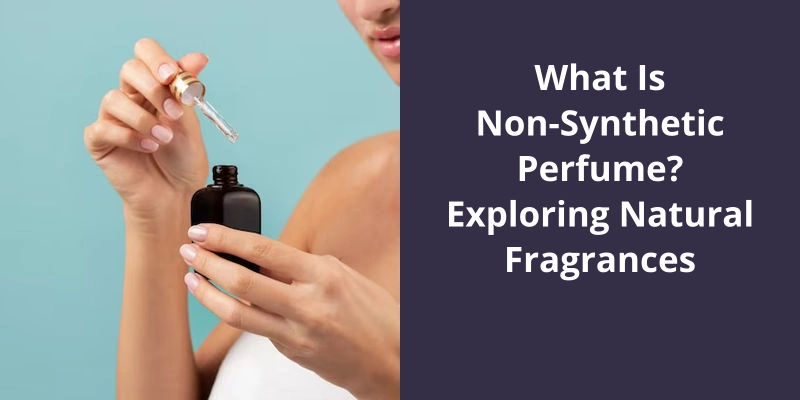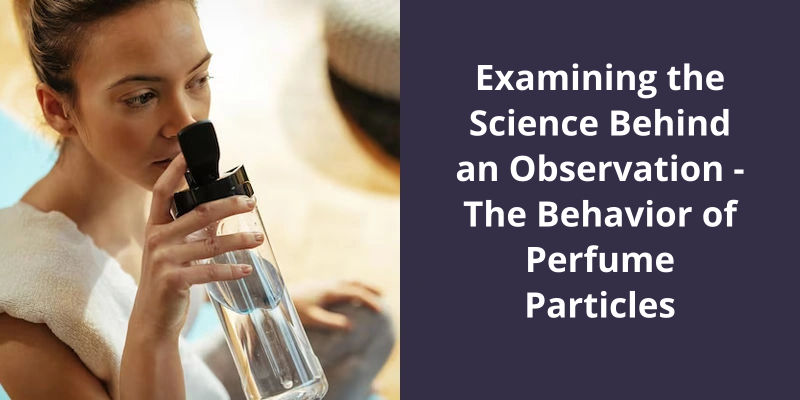Non-synthetic perfume, also known as natural perfume, is a type of fragrance made from pure, natural elements sourced from the earth rather than created in a lab. These can include essential oils, extracts, and resins from plants, flowers, fruits, spices, woods, and even sometimes animal byproducts. They don’t contain any synthetic or man-made chemicals, which are common in traditional perfumes. Non-synthetic perfumes are often favored for their unique, complex scent profiles and their less harmful impact on the environment and potentially on human health. However, they may not last as long on the skin and can vary more due to natural variations in ingredients.

Is Parfum a Synthetic Fragrance?
Parfum, also known as fragrance, is often used as a generic term to describe a wide range of scented products, including perfumes, colognes, soaps, and shampoos. However, it’s important to understand that not all parfum is created equal. In fact, many commercial products labeled as parfum or fragrance actually contain synthetic fragrances.
Synthetic fragrances are artificially created in a laboratory using a combination of chemicals. These chemicals aim to replicate the smell of natural substances or create new, unique scents. While synthetic fragrances can be appealing, they aren’t derived from natural sources. Instead, they’re composed of various synthetic compounds, which may include harmful chemicals and allergens.
When purchasing a product, it’s vital to read the label carefully. Even if a label claims to contain “natural oils,” this doesn’t necessarily mean that the fragrance is non-synthetic. To verify if a fragrance is truly natural, look for the botanical name of the plant on the label. This tells you that the fragrance is derived from the indicated plant and isn’t a synthetic copy.
It incorporates essential oils extracted from flowers, fruits, leaves, or other botanical sources. These natural fragrances are obtained through processes like steam distillation or cold-press extraction, preserving the aromatic compounds found in plants.
Exploring non-synthetic perfumes allows you to immerse yourself in the natural scents of the world. By opting for natural fragrances, you not only enjoy the experience of captivating scents but also contribute to promoting sustainable and eco-friendly practices within the fragrance industry. So, next time you reach for a perfume or personal care product, take a moment to check the label and choose a non-synthetic fragrance that aligns with your values and desire for a more natural lifestyle.
The Cultural and Historical Significance of Perfume: Examining the Role of Perfume in Different Cultures and Throughout History, Including It’s Use for Rituals, Ceremonies, and Personal Expression, Highlighting the Enduring Fascination With Fragrance.
- Perfume has a rich cultural and historical significance.
- It plays a crucial role in different cultures and throughout history.
- Perfume has been used for various rituals and ceremonies.
- It’s also a means of personal expression.
- There’s an enduring fascination with fragrance.
What sets synthetic and organic perfumes apart is the composition of their fragrances. While synthetic perfumes mimic the smell of natural fragrances using chemical compounds, organic perfumes solely rely on natural raw materials. This crucial difference affects not only the scent but also the overall quality and sustainability of the perfume.
What Is the Difference Between Synthetic and Organic Perfume?
When it comes to perfumes, there’s a noticeable difference between synthetic and organic options. Synthetic fragrances are created to replicate the scent of natural fragrances but are made up of chemical compounds consisting of aromatic raw materials. These raw materials can come from both natural and synthetic sources, creating a blend of components. In some cases, the fragrance may be entirely synthetic, lacking any natural elements.
On the other hand, organic or natural fragrances are composed solely of natural raw materials. These materials are sourced from nature, such as flowers, herbs, spices, and even fruits. They’re carefully extracted and blended to create a unique, pleasing scent.
In addition to these common examples, synthetic fragrances are also found in personal care products like perfumes, colognes, soaps, and shampoos. These artificial fragrances are created in laboratories using chemicals to mimic the scents of natural ingredients. They’re often added to products to enhance their appeal and mask unpleasant odors. However, it’s important to note that synthetic fragrances can have adverse effects on human health and the environment, making it crucial to be mindful of the products we use on a daily basis.
What Are Examples of Synthetic Fragrances?
What’re examples of synthetic fragrances? The most common synthetic fragrances are musk, ethyl methoxycinnamate, and phthalates. These synthetic fragrances are widely used in various household products, including air fresheners, scented candles, laundry detergents, and fabric softeners.
Musk is a synthetic fragrance that’s often used to mimic the scent of natural musk, which is derived from the musk glands of animals such as deer. However, due to ethical and environmental concerns surrounding the use of animal-derived musk, synthetic musks have become more prevalent in recent years. Synthetic musks are often more stable and affordable than natural musk, making them a popular choice for fragrance manufacturers.
Ethyl methoxycinnamate is another synthetic fragrance commonly used in perfumes and sunscreens. It’s a UV-absorbing compound that helps protect the skin from the harmful effects of the sun. While it’s effective in it’s sun-protecting abilities, some individuals may experience skin irritation or allergic reactions when exposed to ethyl methoxycinnamate. Therefore, it’s important to conduct patch tests or seek out non-synthetic alternatives if you’ve sensitive skin.
Phthalates are a group of chemical compounds that are often used as a fixative in fragrances to help prolong the scent. They’re commonly found in products such as air fresheners, scented candles, and laundry detergents. However, phthalates have been raising concerns due to their potential link to health issues, including hormone disruption and reproductive abnormalities. As a result, many consumers are now seeking out non-synthetic fragrances that don’t contain phthalates.
Overall, while synthetic fragrances provide a wide range of scents and are commonly found in many household products, there’s a growing demand for non-synthetic fragrances. Natural fragrances that are derived from botanical sources such as flowers, herbs, and spices offer a more sustainable and eco-friendly alternative. Non-synthetic perfumes often focus on using essential oils and plant extracts to create unique and captivating scents. By choosing non-synthetic perfume, one can embrace the beauty of nature and reduce their exposure to potentially harmful synthetic fragrances.
The Environmental Impact of Synthetic Fragrances
Synthetic fragrances have a significant environmental impact. These artificial scents are commonly derived from petrochemicals, which contribute to air pollution and release greenhouse gases during production. When applied to the skin or released into the air, synthetic fragrances can also cause allergic reactions and respiratory problems in individuals.
Furthermore, many synthetic fragrances contain harmful chemicals such as phthalates and parabens, which are known to have detrimental effects on human health and the environment. These chemicals can persist in the environment, contaminating water sources and harming aquatic life.
In contrast, non-synthetic perfumes, also known as natural fragrances, are made from plant-based ingredients and essential oils. These fragrances are generally considered safer and more sustainable, as they’re biodegradable and don’t contribute to air pollution. Natural fragrances also offer a more authentic scent experience, showcasing the beauty and diversity of nature’s aromas.
Conclusion
By utilizing ingredients derived solely from natural sources, such as essential oils and botanical extracts, these fragrances evoke a sense of authenticity and mindfulness. In contrast, synthetic fragrances, which are artificially created in laboratories, may lack the complexity and depth of their natural counterparts.





